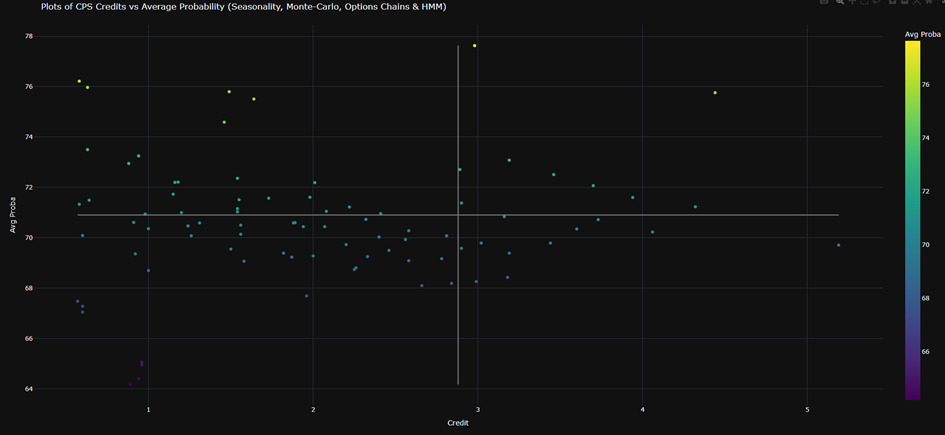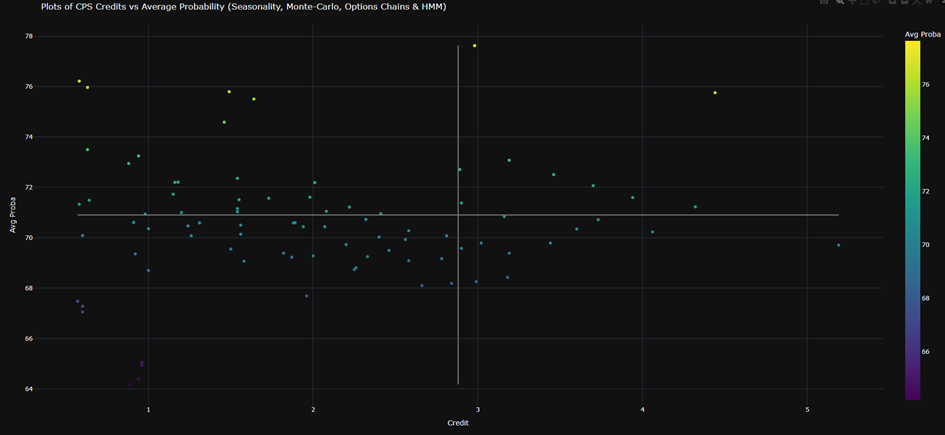Whereas the previous can’t assure future outcomes, it stays our most dependable useful resource for understanding market conduct. Beforehand, I outlined how Monte Carlo simulations can be utilized to estimate these chances. However relying solely on one technique is limiting. Diversifying the methods we calculate chances provides robustness to the evaluation.
On this article, I’ll delve deeply into three further strategies for calculating chances: Hidden Markov Fashions (HMM), seasonality-based chances, and implied chances derived from choices costs. Every technique has distinct benefits and enhances the Monte Carlo strategy, offering a complete framework for assessing Credit score Put Spreads.
1. Hidden Markov Fashions (HMM): Unveiling Hidden Market Dynamics
Hidden Markov Fashions (HMM) are a complicated machine studying approach designed to investigate time-series information. They function on the belief that noticed information (e.g., ticker costs) are generated by an underlying set of “hidden states” that can’t be straight noticed. These states symbolize distinct market circumstances, similar to bullish tendencies, bearish tendencies, or durations of low volatility.
How HMM Works
-
Defining Observations and States:
- The noticed information on this context are the historic closing costs of the ticker.
-
The hidden states are summary circumstances influencing worth actions. For instance:
- State 1 (Bullish): Greater chances of upward worth actions.
- State 2 (Bearish): Greater chances of downward worth actions.
-
State 3 (Impartial): Restricted worth motion or consolidation.
-
Coaching the Mannequin:
- The HMM is skilled on historic worth information to study the transition chances between states and the probability of observing particular worth modifications inside every state.
-
For instance, the mannequin may study {that a} bullish state is more likely to transition to a impartial state 30% of the time, and stay bullish 70% of the time.
-
Making Predictions:
- As soon as skilled, the HMM can estimate the present state of the market and use this info to foretell future worth actions.
-
It calculates the chance of the ticker being above a selected threshold on a given date by analyzing doubtless state transitions and their related worth modifications.
Benefits of HMM in Choices Buying and selling
- Sample Recognition: HMM excels at figuring out non-linear patterns in worth actions, which are sometimes missed by easier fashions.
- Dynamic Evaluation: In contrast to static fashions, HMM adapts to altering market circumstances by incorporating state transitions.
- Likelihood Estimation: For a Credit score Put Unfold, HMM gives a probabilistic measure of whether or not the underlying will stay above the brief strike primarily based on historic market conduct.
By capturing hidden dynamics, HMM provides a extra nuanced view of market chances, making it a invaluable instrument for assessing danger and reward in Credit score Put Spreads.
2. Seasonality-Primarily based Possibilities: Unlocking Historic Patterns
Seasonality refers to recurring patterns in worth actions influenced by elements similar to financial cycles, investor conduct, or exterior occasions. In choices buying and selling, seasonality-based chances quantify how typically a ticker’s worth has exceeded a sure share of its present worth over a selected time horizon.
Easy methods to Calculate Seasonality-Primarily based Possibilities
-
Outline the Threshold:
-
The edge is expressed as a share relative to the present worth (e.g., -2%, +0%, +2%). This normalization ensures the chance calculation is impartial of absolutely the worth stage.
-
The edge is expressed as a share relative to the present worth (e.g., -2%, +0%, +2%). This normalization ensures the chance calculation is impartial of absolutely the worth stage.
-
Analyze Historic Knowledge:
- For a given holding interval (e.g., 30 days), calculate the share change in worth for every historic statement.
-
Instance: If the present worth is $100, and the brink is +2%, depend how typically the worth exceeded $102 after 30 days within the historic information.
-
Combination the Outcomes:
- Divide the variety of instances the brink was exceeded by the overall variety of observations to calculate the chance.
-
Instance: If the worth exceeded the brink in 70 out of 100 cases, the chance is 70%.
Purposes in Credit score Put Spreads
Seasonality-based chances reply the query: “In related circumstances, how typically has this ticker remained above the breakeven?” This strategy is especially helpful for ETFs, which regularly exhibit extra predictable patterns than particular person shares. For instance, sure sectors may carry out higher throughout particular instances of the yr, offering a further layer of perception.
Limitations to Think about
- Seasonality chances rely fully on historic information and assume that previous patterns will persist. Whereas that is typically true for ETFs, it might be much less dependable for particular person shares or during times of market disruption.
3. Implied Possibilities from Choices Costs: Extracting Market Sentiment
Choices costs are extra than simply numbers; they encapsulate the collective beliefs of market members about future worth actions. By analyzing the costs of places and calls throughout numerous strikes for a given expiration date, we will derive the implied chances of the ticker being in particular worth ranges.
Steps to Calculate Implied Possibilities
-
Gather Choices Knowledge:
- Acquire the bid-ask costs for places and calls at totally different strike costs for the specified expiration date.
-
Calculate Implied Volatility:
- Use the choices costs to derive the implied volatility (IV) for every strike. IV displays the market’s expectations of future worth volatility.
-
Estimate Possibilities:
- For every strike, calculate the chance of the ticker being at or above that stage by utilizing IV and the Black-Scholes mannequin (or related strategies).
-
The possibilities are then aggregated to assemble a distribution of anticipated costs at expiration.
Why Implied Possibilities Matter
- Market Consensus: Implied chances mirror what the market “thinks” in regards to the future, providing a forward-looking perspective.
-
Dynamic Changes: In contrast to historic strategies, implied chances adapt in real-time to modifications in market sentiment, similar to information occasions or macroeconomic information.
Utility to Credit score Put Spreads
For a Credit score Put Unfold, implied chances can reply questions similar to: “What’s the market-implied probability that the ticker will stay above the brief strike?” This perception helps merchants align their methods with prevailing market sentiment.
Conclusion
By integrating these three strategies—Hidden Markov Fashions, seasonality-based chances, and implied chances from choices costs—into my present Monte Carlo framework, I’ve developed a sturdy system for evaluating Credit score Put Spreads. This strategy allows a complete evaluation of Out-of-the-Cash (OTM) Credit score Put Spreads amongst a selection of ETFs, filtering for:
- Acquire/loss ratios inside particular thresholds,
- Expiration dates inside an outlined vary,
-
A minimal credit score of $0.50.
The result’s what I prefer to name a “stellar map” of chosen spreads:

accompanied by a abstract desk:

These instruments present readability and actionable insights, serving to merchants establish the perfect trades—these providing the very best chance of success whereas maximizing potential returns relative to danger.
Trying forward, the subsequent step will contain calculating the anticipated worth ($EV) of those trades, combining chances and potential outcomes to additional refine the choice course of.
The final word aim stays the identical: to stack the chances in our favor—not by predicting actual costs, however by estimating chances with precision and rigor.
Keep tuned as I proceed refining these strategies and increasing their purposes!

